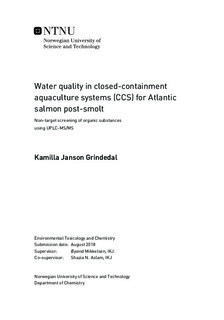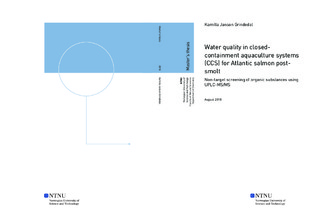| dc.description.abstract | Organic substances may be released in a recirculating aquaculture system (RAS) from a variety of sources such as fish, feed, and bacteria among other. Due to continuous re-use of the water, compounds can potentially accumulate in the system and impact the water quality negatively.
Water samples have been collected from RAS farming Atlantic salmon (salmo salar) post-smolt over a 12-week time period at Nofimas s research station at Sunndalsøra. A novel non-target screening was performed to characterize organic compounds produced in aquaculture in response to various concentrations of carbon dioxide (CO2 mg/l). Physico-chemical parameters included are pH, redox potential, temperature, salinity, conductivity and turbidity. In total the study included 35 samples from fish tanks treated with concentration levels ranging from 5 to 40 mg/l CO2. A liquid-liquid extraction (LLE) and liquid chromatography (UPLC) method was developed and optimized for the water in RAS. Ethyl Acetate (EtAc) stood out as the most suitable solvent for liquid-liquid extraction of the sample matrix followed by Dichloromethane (DCM).
Elevated CO2 concentrations led to significant decrease in pH and increased Redox potential. Despite the significant decrease in pH, the levels were kept within safe recommended levels for farming Atlantic salmon (salmo salar). Twelve organic compounds were tentatively identified and assigned 8 different classes of chemical compounds. The classes which are Organophosphorus compound (OP), Carbohydrate, Amino acid, Ester, Alcohol, Steroid hormone, Ketone and unknowns respectively. Comparison between CO2 treatments investigated (5, 12, 26, 40 mg/l) revealed that the relative level of organic compounds did not differ significantly among treatments over the course of the study, where the majority had a declining trend. Steroid hormones and two compounds of unknown classes were likely metabolites released by fish during acclimatization to the new environment. Increasing levels of these compounds indicated structurally similar compounds produced within the system at the end, potentially toxic to the salmon post-smolt. One compound, Organophosphorus compound, showed signs of accumulation due to high levels detected at the end of the experiment. | en |

